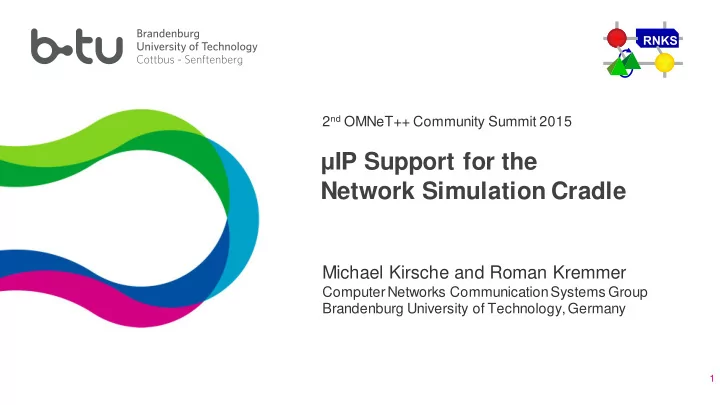

2 nd OMNeT++ Community Summit 2015 μ IP Support for the Network Simulation Cradle Michael Kirsche and Roman Kremmer Computer Networks Communication Systems Group Brandenburg University of Technology, Germany 1
Excerpt of Available TCP/IP Stacks micro IP ( μ IP) vs. lightweight IP (lwIP) vs. FreeBSD IP-Stack ○ 8-bit and 16-bit µC ○ Embedded hardware ○ 32-/64-bit systems ○ KB MBs RAM / ROM ○ ~4KB RAM / ~10KB ROM ○ ~20KB RAM / ~40KB ROM ○ Compliant with TCP, UDP + Full-scale stack with DNS, + Full-scale stack with DNS, PPP, ARP, DHCP, … PPP, ARP, DHCP, … and IP RFCs + Standalone version as well + Standalone as well as OS ○ Embedded in FreeBSD as Contiki integration support (multiple systems) + IPv6-ready ( μ IPv6) – Experimental IPv6 support + Full IPv6 support – Uses only 1 packet buffer, + High performance in + Highest performance in throughput problems almost all use cases all use cases AppLayer retransmission – Standalone version does – Requires Linux OS, + Socket as well as raw / not support socket API native API for performance no standalone support 2
Excerpt of Available TCP/IP Stacks micro IP ( μ IP) vs. lightweight IP (lwIP) vs. FreeBSD IP-Stack ○ 8-bit and 16-bit µC ○ Embedded hardware ○ 32-/64-bit systems ○ KB MBs RAM / ROM ○ ~4KB RAM / ~10KB ROM ○ ~20KB RAM / ~40KB ROM ○ Compliant with TCP, UDP + Full-scale stack with DNS, + Full-scale stack with DNS, PPP, ARP, DHCP, … PPP, ARP, DHCP, … and IP RFCs + Standalone version as well + Standalone as well as OS ○ Embedded in FreeBSD as Contiki integration support (multiple systems) + IPv6-ready ( μ IPv6) – Experimental IPv6 support + Full IPv6 support – Uses only 1 packet buffer, + High performance in + Highest performance in throughput problems almost all use cases all use cases AppLayer retransmission – Standalone version does – Requires Linux OS, + Socket as well as raw / not support socket API native API for performance no standalone support 3
Why microIP ? Sensor Node‘s Stack End- System’s Stack Application CoAP MQTT uXMPP ... CoAP MQTT XMPP ... Layer Transport UDP TCP UDP TCP Layer Gateway‘s Stack uIPv6 ICMPv6 uIPv6 ICMPv6 ND ND ND Routing Routing Network ND Routing Layer IPv6 ICMPv6 IPv6 ICMPv6 ND 6LoWPAN Routing ND 6LoWPAN MAC & PHY MAC & PHY MAC & PHY MAC & PHY Data Link & (e.g., IEEE 802.15.4-2006) (e.g., IEEE 802.15.4) (e.g., IEEE 802.3) (e.g., IEEE 802.3 / 802.11) Physical Layer . . . . . . Part of a cyber physical system 4
Why simulate μ IP in OMNeT++ ? • microIP is usually tested via: 1. Live experimentation on real systems • Deployments hard to control, low repeatability, costs, … 2. Testbeds • Low scalability, set- up inflexible, limited control of external factors, … 3. Cooja (Contiki OS simulator) • Cycle accurate emulation and possible interconnection to real systems • Limited simulation and comparison of/with systems/models outside the Contik world Tackle these issues (+ more) through generic OMNeT++ simulation 5
What is the Network Simulation Cradle ? • Developed by Sam Jansen • Basic idea: Integrate kernel-space implementations of real world network stacks into ns-2 / OMNeT++ (instead of failure prone / abstract modeling) • Basic approach: • Parse the C-code, • Substitute global variables through arrays of per-node-instance variables, • Recompile as a shared library, • Map interfaces to ns-2 / OMNeT++ through glue code. • Works without manual code changes in contrast to “plain” porting of stacks • E.g.: Bless and Doll “Integration of the FreeBSD TCP/IP -Stack into the Discrete Event Simulator OMNet ++” 6
How to integrate μ IP into the NSC ? • OMNeT++ Simulator Process differs a bit for different microIP versions (w/o API) … send listen connect close abort … 1. Integrate μ IP source code into Simple Module for NSC NSC build process (TCP_NSC like ITCP) 2. Implement stubs for references to Interface … connect send listen … unused system functions 3. Adjust globalizer parser for μ IP uIP Shared Library (libuip.so / libuipv6.so) 4. Create new netstack drivers for Simulator (OMNeT++) interface and Contiki (to redirect calls to NSC) support code (sim_support.cpp) 5. Create config files and integrate uIP Stack into an OMNeT++ simulation (incl. netstack components with NSC support) 7
How to use μ IP in OMNeT++ ? • Prerequisite: • 32-bit Linux NSC requirement • Source code from Github • Steps: • Copy our code into extracted NSC • Compile shared μ IP library ( libuip.so / libuipv6.so ) • Adjust LD_LIBRARY_PATH • Enable NSC / recompile simulation • Setup omnetpp.ini 8
In Conclusion • μ IP support in OMNeT++: • Further actions: • • Provided via the NSC Full IPv6 integration (NSC officially has IPv6 support, • Currently support for IPv4 function calls yet always go to v4) • Packet exchange between • Combine with IEEE 802.15.4, different stacks possible 6LoWPAN and applayer protocol Another stop along the road of Possible integration of other IoT simulations with OMNeT++ stacks in the future (e.g., RiotOS) 9
Recommend
More recommend